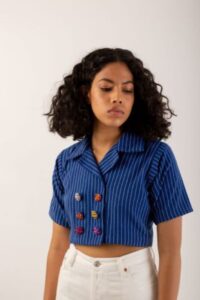Contemporising Phulkari designs

Aab is making Phulkari designs on daily-wear garments
Rajkumari Sharma Tankha
Pained at the deteriorating quality and quantity of ‘hand-crafted’ Phulakris, Shreya Mehra founded ‘Aab’ last year. A media graduate from the London School of Economics and Political Science, Mehra strongly believes in preservation of traditional handicrafts. “But this can only be done if there is a demand for them. And demand can be created only by moving the art from the confines of history and contemporize it,” she says, adding that’s what Aab is doing. While the form of the garment has changed from dupatta to versatile every-day wear, the raw material and techniques remains the same age-old. “Each piece at Aab is painstakingly created with 100 per cent hand-woven fabric just like the antique Phulkari done on Khaddar, which is always hand embroidered with illuminous patt silk thread utilising traditional Phulkari techniques and designs – Baghs, Darshan, Dewars, Sainchis, Thirmas and Chopes,” says Mehra. Excerpts from an interview:
From a media graduate to a fashion entrepreneur… how did the transition happen, and why?
I’ve always been a creative person; once an idea struck, there was no turning back. I see it all as an expression of my creativity, from writing to running a fashion label. I identify with this craft because of my background. Growing up in Amritsar, I had a sentimental and inspirational connection to Phulkari. Phulkari was ideal because it felt like my design process, and thus my personal evolution, had completed a full circle. This was my way of getting back in touch with my roots and the things that have come to define my design intellect.
Aab Founder Shreya Mehra
What explains your interest in Phulkari?
I grew up in Punjab and was always intrigued by its art, history & culture. It was from the sole perspective of gifting a piece of culture that I first started looking for hand-embroidered Phulkari and bought a jacket for my friend which was created using an antique piece. The lack of variety made me do my research and understand the why behind it. When I finally decided to reimagine Phulkari, I visited many Phulkari clusters to gather info. Apart from that, the testing the concept happened through an 8-piece display of Phulkari dresses and tops at a local event and through feedback from friends & family.
How did you go about setting up a business?
Aab Label is bootstrapped. Since I was changing fields while setting this business up, I was clueless about even the basics of it. I bugged my friends from fashion & design with the initial inputs, saw tons of youtube videos & then made a plan with things that were utmost necessary to launch the brand. Based on this I started contacting vendors to kickstart the project, from artisans to Web Developers – I started talking to more & more people to find the right fits.
What roadblocks came your way and how did you overcome them?
Since hand-embroidered Phulkari wasn’t a commercially done craft – finding good quality and craftsmanship was the biggest challenge. Additionally, as a women entrepreneur initially many vendors and people I was interacting with didn’t take it too seriously and it was hard to get my vision out there initially. But along the way I learnt the fine balance between asserting when needed to get things done and letting go at times!
Is it tough dealing with karigars?
Interestingly, dealing with Kaarigars is easy. They are receptive to new ideas and designs while being super clear in conveying their challenges with the designs we give. It’s like a team – we hear what they say, they listen to their ideas and see the skill before final motifs are made. They come up with some amazingly creative suggestions at times too!
How do you quality control the whole process?
One has to be stubborn to quality control at all times, and that’s not easy. We have checks and balances at every step of production from sourcing to cutting and stitching. After every step, a thorough check is done before proceeding to the next one. We have a set of strict guidelines in place – from artisans to tailors, every team follows what concerns them while being constantly monitored.
Does Phulkari in Western outfits sell?
It sure does. Rather, that’s the sole way of garnering more traction for the craft which was earlier confined to just Punjab. We want to make a strong statement, something that would resonate with the consumer who values the handcrafted. There are very few high-fashion designers who create Western contemporary clothing using Indian techniques without falling into the category of “ethnic.” We’re attempting to reinterpret Punjab’s traditional Phulkari embroidery and incorporate it into Western outfits. This entire initiative also helps provide livelihoods for artisans who were being replaced by machines.
How has been the last one year for business, and how do you foresee the future.
Well, the last has got us some good accolades and feedback. But being the first year. We are still less than a year old. It has been about learning, striving & taking baby steps! Onward & upward!





